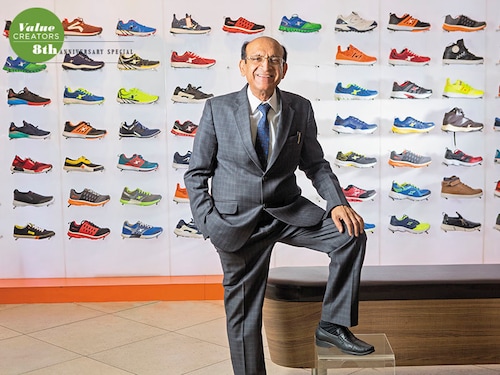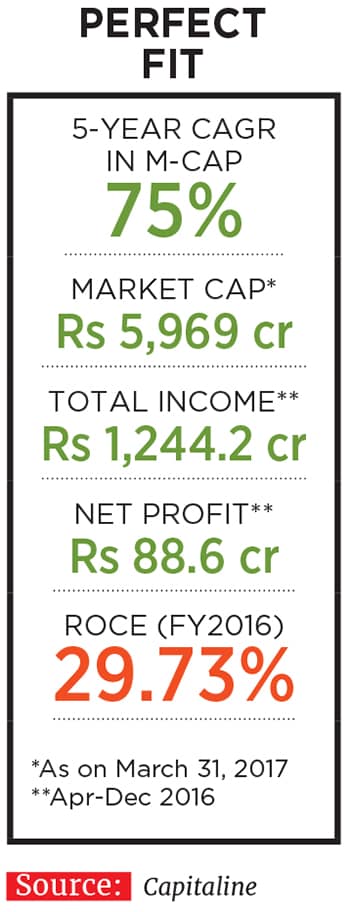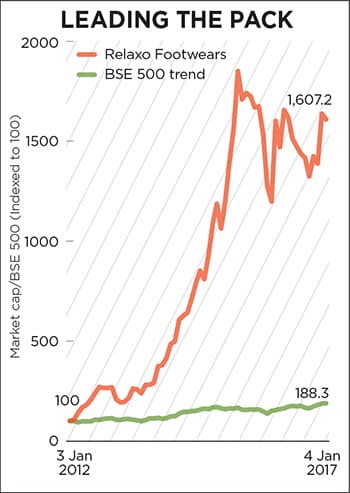From just a single product in 1976, Relaxo has come a long way
By focusing on quality and branding, and by always looking ahead, the Dua family has made Relaxo India's largest footwear manufacturer


 Stepping on it: Ramesh Kumar Dua, managing director, Relaxo Footwears
Stepping on it: Ramesh Kumar Dua, managing director, Relaxo Footwears
Image: Madhu Kapparath Spend time with Ramesh Kumar Dua and it quickly becomes apparent how passionate he is about the footwear business. The hour-long meeting with Dua, for instance, is regularly punctuated by his walking me to a wall of his office where his products are displayed, and explaining why he believes a particular pair of slippers has caught the fancy of customers. “Just the manner in which your big toe slides into a slipper can result in the success or failure of a product,” says the 63-year-old managing director of Relaxo Footwears, a company that makes quality affordable footwear.
The Delhi-based company, which started in 1976 with just one product—the indispensable hawai chappal—has grown to become the maker of 400 different types of shoes and slippers across four brands, covering everything from hawai chappals to sneakers. Over the last four decades, Relaxo has also grown to become the largest Indian footwear manufacturer by number of pairs sold—it sold 135 million pairs last fiscal year. Compare that to the nearest competitor in the Indian market, Bata, which sold 21 million pairs, and you see the magnitude of the success.
Relaxo’s is the story of an incredible journey of a company’s relentless focus on quality, and later building a brand, with everything else inexorably falling in place. Simply put, it has been rewarded for its quality that is available at an affordable price point.Dua estimates that since its inception, the company has compounded its revenues by 28 percent every year. In the year ended March 2016, Relaxo had revenues of Rs 1,713 crore and profits of Rs 120 crore, and a market cap of Rs 5,969 crore. Its return on capital employed was 28.6 percent. The stock has registered a CAGR of 72 percent per year over the past five years.
The company is now well positioned to take advantage of the growing demand for footwear among Indian consumers. Its products are seen as aspirational (Bollywood celebrities are brand ambassadors), it has set up more than 250 company-operated stores, and its average price point of Rs 125 per pair makes it affordable to a large mass of Indians. Unlike brands like Bata and Metro Shoes, Relaxo has taken a conscious decision to stay away from leather shoes where the prices may be higher but the market size is much smaller.
The Early Years
In 1976, after trying their hand at the businesses they inherited—including manufacturing cycle parts and footwear—the Dua family decided to focus exclusively on footwear. They had come out of a difficult family business separation in 1971—where the business interests were divided between Dua’s father and his brother. As a result of that separation, Dua’s father had to take on the creditors of the family business, who owed the family Rs 1 lakh. But when he went to collect the money he realised they were unwilling to pay up, and he eventually had to write the money off his books. “So we started with a deficit of Rs 1 lakh,” Dua explains.
The family rented out a property they had at Rs 350 a month for which they also took a deposit of Rs 10,000. It was this money that became the initial capital with which they started Relaxo. But, to make a mark, Dua knew he had to understand more about the key commodity his business would use—rubber.
Discovered in the Amazon forests, and later brought to Asia, rubber has played a vital role in the growth of various industries, from car tyres to footwear. Securing supplies was so important that in 1926, Henry Ford set up his own town, Fordlandia, in Brazil, to source rubber for his company.
But in his pursuit of knowledge, Dua faced another hurdle. As a commerce graduate, he did not meet the criteria for entry into a programme offered by the Plastics and Rubber Institute, UK. He recalls showing up at their doorstep and seeking admission into the programme, where the pass percentage was only 2 percent. As he did not meet the criteria, they refused to admit him. “I told them that I only want to learn, I don’t need a degree,” he says. “When they heard that they asked me to pay the fees and start attending classes.” 
Ramesh Kumar Dua (right) being conferred the LPRI degree (Licentiate of Plastics and Rubber Institute, London) in 1983Dua credits a large part of the success of the company in its initial years to his understanding of his raw material. He is a qualified rubber technologist and also studied commerce, so he has a good understanding of business issues as well.
Even in the initial years, Dua knew he was aiming for both quantity and quality. They set up several units under different names as the footwear sector was reserved, by the government, for small scale manufacturers. Apart from focusing on quality, they also decided they needed a name to differentiate it from all the unnamed products in the market at the time. The name ‘Relaxo’ was introduced so that they could demand better terms from their distributors.
Dua recalls the decision to set up a brand was taken during the Emergency as he believed that if he had a brand, retailers would not remove his products from their stores overnight as they did with other unbranded footwear during the time. If customers asked for the shoes by name, shopowners would have to keep stocks.
Building a Brand
In 1995, when the government changed the rules and the sector was no longer reserved for small scale industries, Relaxo grabbed the opportunity with both hands. They quickly set up a plant at a cost of Rs 7.5 crore that could manufacture 50,000 pairs a day, “an exponential jump”, as Dua puts it. The company had raised Rs 4.5 crore in an initial public offering, Rs 1.5 crore came from internal accruals and a loan for Rs 1.5 crore was taken. This was also the time when the economy was opening up and Dua recalls that demand for shoes was burgeoning.  At the same time, Relaxo also made its first tentative move into advertising to create a brand that would resonate with customers. Dua was always a believer in the power of advertising. He points to the fact that in 1976 he would pay for a radio jingle. “Paying Rs 100 per jingle is what I could afford then and I did it,” he says. Relaxo now has four brands: Bahamas, Sparx, Flite and Schoolmate. “As the brand pull is there, we have, over the years, been able to command better margins from retailers,” says Ritesh Dua, his nephew, 39, who is executive director in charge of finance, exports and HR. Relaxo now spends money on roping in Bollywood actors like Salman Khan, Akshay Kumar and Sonakshi Sinha to advertise their products. “This not only makes the products aspirational but also creates a significant barrier for a new entrant trying to take Relaxo’s position. A new entrant will not be able to bear the advertising expense needed to create a brand. Relaxo now has the size and scale to apportion this expense over 135 million pairs. This is a significant moat,” says Sanjay Bakshi, an investor in the company. Industry watchers also say that with an average pair realisation of Rs 125, there is significant potential for the company to take this up. Even a growth of 10 percent in volumes and a price increase of 10 percent a year can see the company grow at 20 percent a year for many years to come.
At the same time, Relaxo also made its first tentative move into advertising to create a brand that would resonate with customers. Dua was always a believer in the power of advertising. He points to the fact that in 1976 he would pay for a radio jingle. “Paying Rs 100 per jingle is what I could afford then and I did it,” he says. Relaxo now has four brands: Bahamas, Sparx, Flite and Schoolmate. “As the brand pull is there, we have, over the years, been able to command better margins from retailers,” says Ritesh Dua, his nephew, 39, who is executive director in charge of finance, exports and HR. Relaxo now spends money on roping in Bollywood actors like Salman Khan, Akshay Kumar and Sonakshi Sinha to advertise their products. “This not only makes the products aspirational but also creates a significant barrier for a new entrant trying to take Relaxo’s position. A new entrant will not be able to bear the advertising expense needed to create a brand. Relaxo now has the size and scale to apportion this expense over 135 million pairs. This is a significant moat,” says Sanjay Bakshi, an investor in the company. Industry watchers also say that with an average pair realisation of Rs 125, there is significant potential for the company to take this up. Even a growth of 10 percent in volumes and a price increase of 10 percent a year can see the company grow at 20 percent a year for many years to come.
As the company has grown from a family business to a large footwear manufacturer, there has also been a serious attempt to professionalise. Through a two year-long engagement with Accenture, started in 2012, Relaxo beefed up its human resource policies (KRAs are now defined), implemented data analytics to forecast demand more accurately as well as granted employee stock options. All these have helped the company retain talent as well.
“Within the company there was a view that if we increased volumes, profits would come automatically. Accenture taught us that profitable growth has to be an end in itself,” says Ritesh Dua. He cites the example of its Sparx range of footwear, which was struggling to grow. The advice given to the company was that prices needed to be cut by 20 percent, so they went about reengineering the product and the way it was manufactured. The re-launched Sparx has been a huge success.
undefined Like all entrepreneurs who have built their business from scratch, there is a tendency to go with gut feelings [/bq] Yet, like all entrepreneurs who have built their business from scratch, there is a tendency to go with gut feelings. Dua, not a fan of excessive market research, narrates a hilarious story about how market research showed that the safest place for a person to walk on the road is at its centre. “It’s obviously going to be the safest no one walks on the road for fear of being run over,” he says with a laugh.
Then there are the 250 Relaxo brand stores the company has set up. As the size of its offerings grew, Dua realised that most retailers were unable to stock the entire range. He was at the India International Trade Fair at Delhi’s Pragati Maidan in 2005 when he saw visitors gaping at the range of Relaxo products on offer. “They said they had never seen these at our retailers,” he says. That prompted him to start setting up company-operated stores, which now contribute Rs 120 crore in revenue. The stores also stock leather products by other manufacturers.
These stores also serve a strategic purpose. They enable the company to gather market intelligence, with a clear idea of which products are doing well. Earlier, it would rely on the distributor for such information, and distributors always had a vested interest in pushing certain products, perhaps due to the profit margin. Now the company is able to forecast demand a lot better and is able to adapt to changing seasons.
With the next generation firmly in place (Dua’s sons as well as his brother’s—whole time director Mukand Lal Dua, 68— are part of the business), the company seems to have the next decade of growth firmly within its grasp. “Relaxo’s growth is not a short-term trend. It will continue,” says Bakshi. Other people who have invested in and tracked the company say that the Dua family is among the most down to earth they have met. The offices till just a few years ago operated from a nondescript building in New Rohtak Road, an industrial area in Delhi. “They always pay their suppliers in time,” says an investor who declined to be named. All this, along with their impeccable roster of products for India’s middle class, make Relaxo a growth story worth watching for many years to come.
First Published: May 15, 2017, 07:47
Subscribe Now